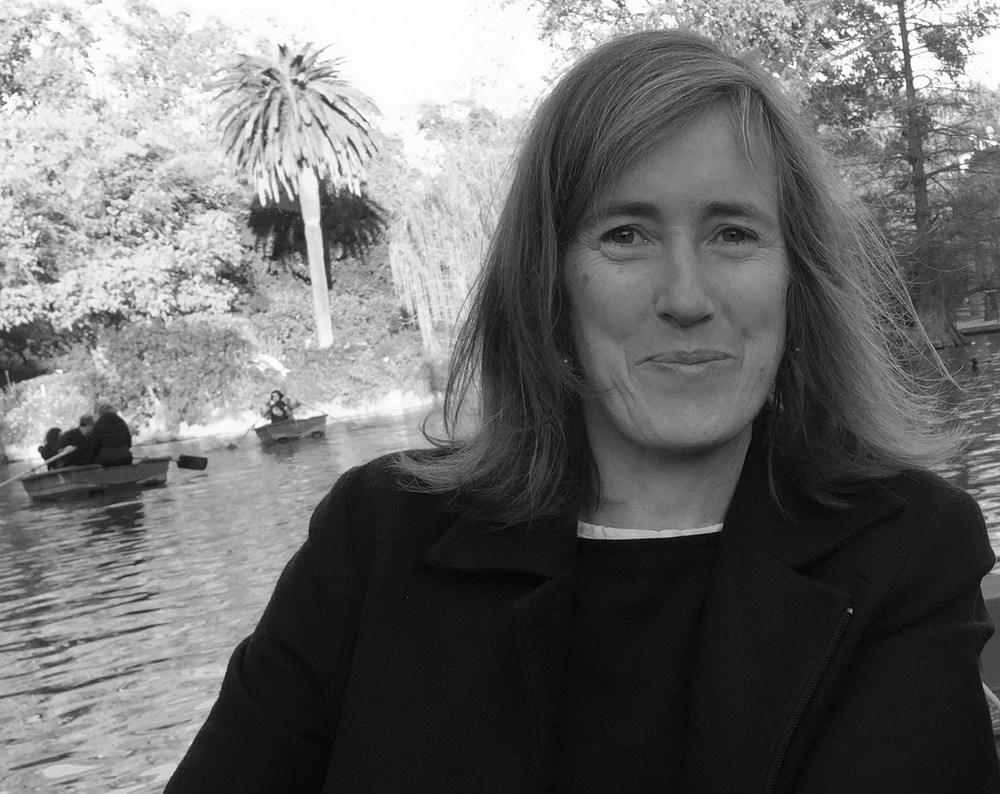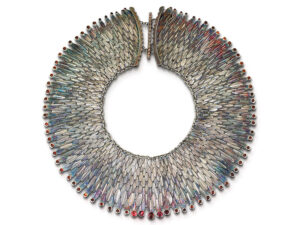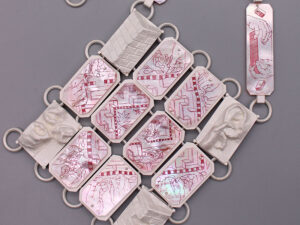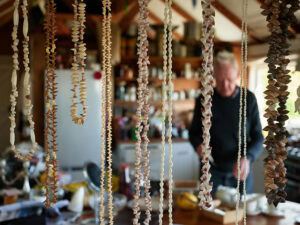Vicki Mason: You had extensive jewelry training in your early years as a maker. What learnings have stayed with you from this time and shaped your practice?
Kim Buck: Everything I do now is not only directly connected to my education as a goldsmith, but as much connected to my growing up in my father’s workshop. My father is a machine engineer and had a factory where my brothers and I spent our time after school. Most of my work has an innovative aspect. I’m interested in finding new ways of expressing my ideas.
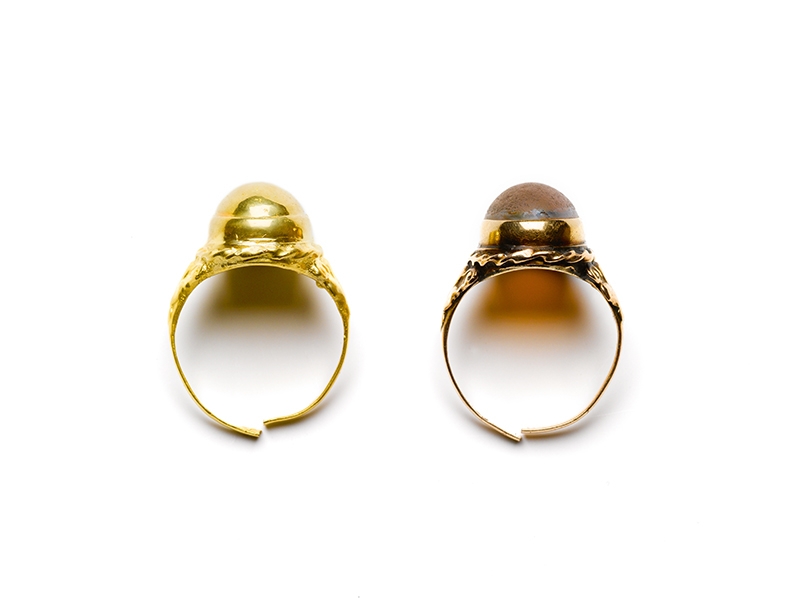
Your interest in making jewelry about jewelry characterizes much of your recent work. What key themes, issues, motifs, and ideas are you drawn to question through your investigations and making of jewelry about jewelry? Can you give some examples illustrating your work in this area?
Kim Buck: First of all, it’s very important for me that my jewelry be easy to wear. Ninety-nine percent of my jewelry works well worn. One percent of it is more like tableaus about jewelry, but I still call those pieces jewelry because otherwise they don’t make sense. Copy (2007), Diamond Ring (2005), Life Savers (2014), It’s the Thought That Counts (2001), and more are good examples of this.
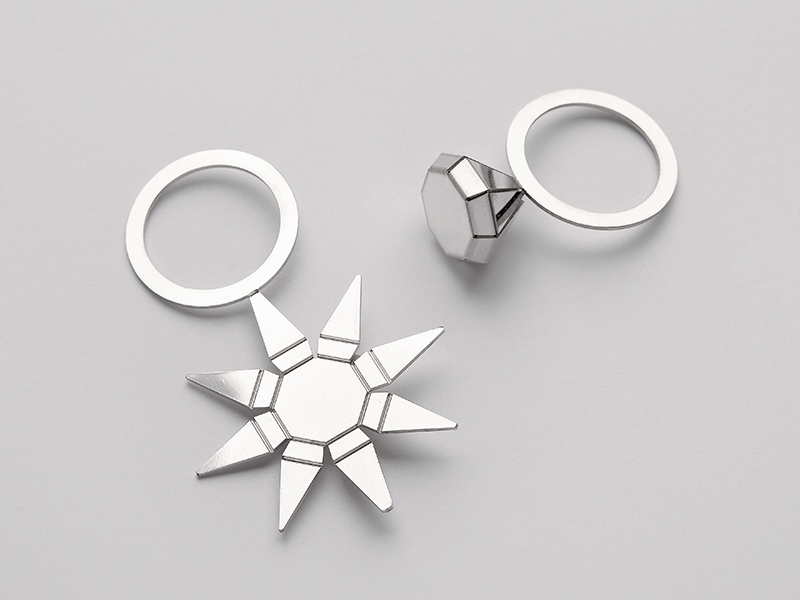
Works like your tiny popcorn machine designed to pop a single (square) kernel of corn, Sponge-o-matic, and your Holloware object suggest that humor plays a role in your work. What do you think humor, as a psychological construct or phenomenon, brings to jewelry?
Kim Buck: Traditionally, jewelry is serious business, so I guess I can’t help it. It’s not something that I try to do, it just turns out like that. I think about my titles a lot; sometimes the titles come first because a funny title or euphemism came to mind. I made an exhibition that I called The Newest Testament and a piece I called Give Us All Our Daily Bread. These are examples of changing something we know just a little bit—like tripping people to stop and think. I guess humor is a good way to catch people’s attention.
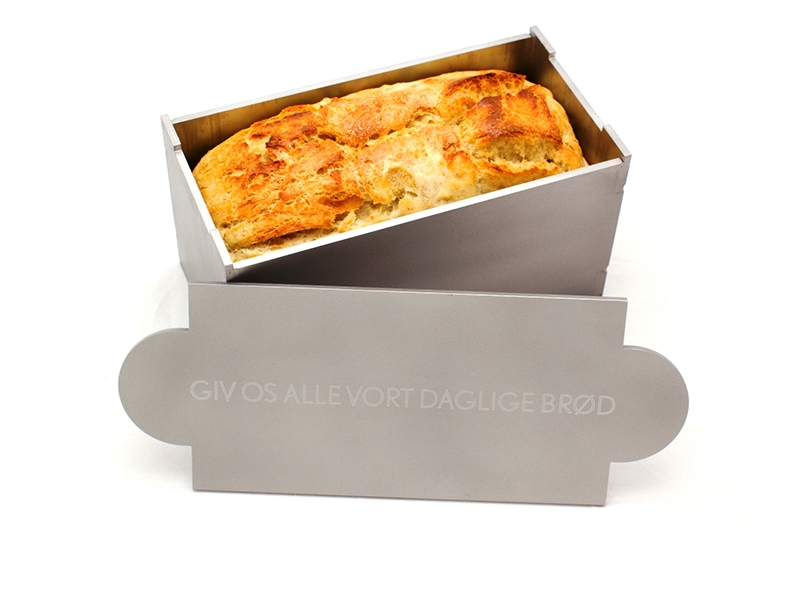
You use a form reminiscent of dumbbells or fishing weights in your series Life Savers and Crossing Borders. Where does this form come from, and why does it resonate?
Kim Buck: As I tell students to say, when they don’t know what to say—it’s an aesthetic choice. It’s difficult to argue with that. It has somehow become a signature for me, with a bulky eye also seen in Precious Stones. In Crossing Borders, I had to have a wide sprue for casting since I cast them one by one with “potato casting.” The form of the pendants is simple and it’s easy to calculate the weight; this was important so that one beer can was enough metal for one pendant.

The pendants in your Life Saver series are shown in images worn on the body as well as grouped together housed in a series of clear covered boxes/cabinets. They appear to have an “on” and “off” character, being both wearable and sculptural at once. Please talk about this installation and the sequential nature this co-dependency implies.
Kim Buck: The Life Savers pieces are jewelry about jewelry. We all know the almost physical feeling of having forgotten our ring or other jewelry that we usually wear. I see this emergency box hanging in your hallway so that you, in a hurry, can put on your Life Saver. The photo with 64 boxes is from the exhibition and not really important for the meaning. Materials and aesthetics are recognized from life-saving equipment. Life Savers are both a statement and a piece of jewelry.

Can you tell us how a work or new series of works comes into existence? Do you work from an idea that is then translated into drawings, models, etc., or do you go straight to your materials, for example, or develop works that follow from one to another?
Kim Buck: My ideas come in many different ways. Sometimes I think of a good title or saying that I can use, then think about how to visualize this and what technique does it best. Sometimes I come up with a technique and find out what it can express. For many years I have made a lot of social comments, it’s easy these days to find topics.
Most of my work has a technically innovative aspect that I spend a lot of time with. I like to find or invent techniques or combine known techniques in a new way to be able to express a specific idea. I don’t sketch much; I never make “drawings” that I save. I do have a notebook, but it contains mostly written notes of ideas not to forget. I know what to do when I start working, even though it very often changes a lot along the way.

You run a gallery alongside your studio/workshop. How do you maintain a balance between making your own work, traveling, developing new projects, holding exhibitions, and selling work through the gallery?
Kim Buck: Good question. I always feel the balance is off. The Most Secret Gallery was an experiment because I missed certain kinds of exhibitions in Denmark. I didn’t have many exhibitions in the gallery; it has always been an expense rather than an income. I realized how much work it is just to arrange a talk, not to mention an exhibition. The time always goes from making. Financially, I’m so lucky to have a rare lifelong grant from the Danish Arts Foundation, which is an important supplement.
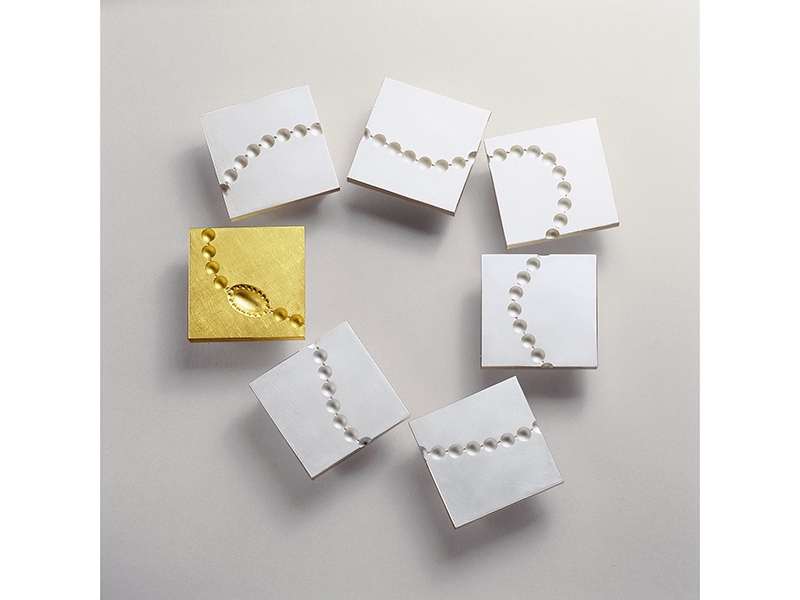
Do you still design for Georg Jensen, and how has this work influenced your own work, if at all?
Kim Buck: I’m not a designer for Georg Jensen anymore. Not that we parted officially, but it faded out. I still design for other companies, though. I like this way of working. I like the boundaries, etc. When I get an idea, I think about what direction to give it. Commercial or my own personal work. I more or less work with it the same way, so the influence goes both ways.
Environmental consciousness and questions surrounding issues related to mining and resource use continue to come to the fore for makers of jewelry. Do you ever think about the sustainability of the materials you use?
Kim Buck: The Precious Stones project and the Crossing Borders project come from these issues. I think quite a lot about these things. In my studio, I have found ways to not use harmful chemicals or processes as was common before—this is one thing that I find most people forget to look at.
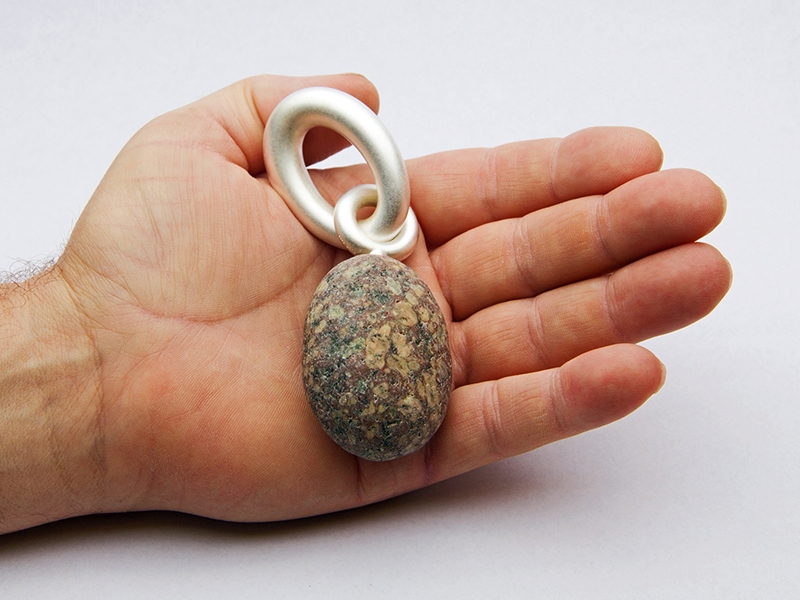
You’ve been a goldsmith, designer, and jewelry artist for a long time now. What advice can you give to those just starting out?
Kim Buck: When I look at my own career, I can say that work discipline has been the most important factor. If you don’t work every day, you don’t have a continuous flow in your work. I work very fast when I make my work—it’s how I survive, it comes from experience, which comes from working a lot.
What’s next for you, workwise? Any big projects on the boil?
Kim Buck: I have several projects I’m working on. As always. One is Made in China, which is a porcelain project. I go to China in two weeks to work on this.

Do you wear any jewelry?
Kim Buck: I usually wear small brooches or pins.
When you aren’t working, what do you love to do?
Kim Buck: Maybe the most difficult question … I never actually looked at what I do as work. But I do like sometimes to do nothing. I have an interest in mechanical musical instruments and have built a couple, and I’m working on a very large one at the moment—but that may be work.
***
インタビュー
2018年5月21日
キム・ブック
ヴィッキ・メイソン
革新、ユーモア、美しさ、高い技術、挑戦、洗練、目を奪う存在感——これらの描写はキム・ブック氏の作品を表す言葉のほんの一部にすぎない。キム・ブック氏の長年の活動を支えてきたものは何なのか。このインタビューは、思慮深い回答からその答えが明かされる、教訓に富む内容となった。ジュエリー界の一員としてその才能をいかんなく発揮するキム・ブック氏の進化は続く。
ヴィッキ・メイソン:作り手としての教育を受ける際、最初の数年間で広範囲にわたる内容を学んだそうですが、そのなかで、現在も継続していて今の制作スタイルの形成に役立ったのはどんなことですか?
キム・ブック:私がいまやっていることはすべて、ジュエリー職人になるための修業の賜物ですが、父の工場で過ごした少年時代に負うところも大きいです。放課後は兄弟といっしょに、機械工学の技師である父が持っていた工場に入り浸っていたのでね。私のほとんどの作品には発明的な要素が含まれます。私はアイデアを表現する新しい方法を見つけ出すことに興味があるのです。
近年のあなたの作品の大きな特長として、「ジュエリーにまつわるジュエリー」に対する関心が見られます。このような作品を作るに際しては、主にどのようなテーマや問題、モチーフ、アイデアが契機となって、問いかけから考察、制作へつながっていくのでしょうか?また、ご自身の作品群から「ジュエリーにまつわるジュエリー」の例をいくつか挙げていただけますか?
キム・ブック:私は、第一につけやすさをとても重視しています。私が作るジュエリーの99パーセントは着用性の高いものです。残りの1パーセントはジュエリーを描き出したキャンバスという趣が強いですが、そういう作品もジュエリーと呼んでいます。そうでなければ意味をなしませんからね。そういった作品の具体例には、「コピー」(2007年)、「ダイヤモンド・リング」(2005年)、「ライフ・セイバー」(2014年)、「大切なのは気持ち」(2001年)などがあります。
あなたが制作した、トウモロコシを一粒だけ吐き出す小型のポップコーンマシーンや「機械式のスポンジ」、「ホローウェア」などの作品からは、ユーモアの要素がうかがえます。心理的な構成概念や現象としてのユーモアは、ジュエリーになにをもたらすと思われますか?
キム・ブック:ジュエリーは長らくお堅い稼業とされてきたからこそ、ユーモアを加味せずにはいられないのだと思います。努めてそうしているのではなく、結果的にそうなってしまうのです。タイトルについてはよく考えますが、笑えるタイトルや婉曲的な言い回しが思い浮かんで、先にタイトルが決まることもあります。「最新約聖書」という展覧会を開催したり「我らの日用の糧を今日もあらん限り与えたまえ」(※原題は「Give Us All Our Daily Bread」で聖書の一節である「Give Us Our Daily Bread」に由来する。日々の糧をパンになぞらえた表現)という作品をつくったこともありますが、これらは既知の言葉をもじった例で、人々に足を止めて考えてもらうための仕掛けといえます。ユーモアは人々の注意を引くための有効な手段ですからね。
「ライフ・セイバー」や「クロッシング・ボーダーズ」のシリーズの造形は、ダンベルや釣りの重りを思わせますが、このような形を選んだ理由やこれらの形に親しみを感じる理由を教えていただけますか?
キム・ブック:私は学生に、どう説明していいのかわからない時は、審美的な判断でそうしたと言えばいい、と伝えています。もしそうなら論拠を示すのは難しいですから。自分にもそういう傾向があって、「宝石」で使った極太の丸カンはその例です。「クロッシング・ボーダーズ」にも同様の丸カンがみられますが、こちらは「ポテト鋳造」で一点一点鋳造したので、太い湯道(※鋳造時に型に金属を流すための通路)が必要だったせいです。ペンダントの形はシンプルなので重量計算がかんたんです。ペンダントひとつをビール缶ひとつ分以内の金属で収められるようにするには、この点が重要でした。
「ライフ・セイバー」シリーズのペンダントは、人が身につけているところと、透明な蓋つきの箱に収められているところの両方のイメージが提示されており、着用時と非着用時という、着用性と彫刻的な性質の両面が同時に示されています。この見せ方と、ふたつの状態の共依存関係が示唆する連続性についてお話していただけますでしょうか?
キム・ブック:「ライフ・セイバー」の作品群はジュエリーにまつわるジュエリーです。人は、指輪にしろ、それ以外のアイテムにしろ、いつもつけているジュエリーをつけ忘れると、体の一部を忘れたかのように感じるものです。でも、この非常用の箱を廊下に設置しておけば、急いでいても「ライフ・セイバー」をつけられます。64個の箱が映った画像は展示風景で、そういった意味ではさほど重要ではありません。「ライフ・セイバー」は意見表明でもありジュエリーでもあります。
どのようにして新しい作品が生まれるのか教えていただけますか? アイデアをスケッチやモデルに発展させるのか、それとも素材をいじるところから始めるのでしょうか? あるいは、ひとつの作品が次につながって、というふうに順序だって発展していくのでしょうか?
キム・ブック:発想の方法はさまざまです。使えそうなタイトルや言い回しを思いついて、それを視覚化する方法やそれを実現するにはどんな技法がいちばんしっくりくるかを考えるという時もあれば、技法を思いついてからそれを使って何を表現できるか考えることもあります。長年にわたり、社会的なコメントも多々表明してきましたが、近年はそのネタに事欠きませんね。
私の作品の大部分は技術面での革新性を扱っており、私はそれに多くの時間を費やします。技術の発見や考案も好きですし、既知の技術を新たな方法で組み合わせて特定のアイデアを表現するのも好きです。スケッチはあまり描きません。「ドローイング」を描いてとっておくこともありません。ノートは持っていますが、主にアイデアを文章で書き留めるための備忘録として使っています。途中で変更を加えることも多々ありますが、作業さえ始めてしまえば何をすべきかわかります。
あなたはスタジオ/工房のほかにもギャラリーを運営していらっしゃいます。どのようにバランスを取りながら、制作と旅行、新しいプロジェクトの企画、展覧会の開催、ギャラリーでの販売業をかけもっていらっしゃるのでしょうか?
キム・ブック:いい質問ですね、私は常々バランスが取れていないと感じているので。The Most Secret Galleryは、デンマークではある種の展覧会を見られないと感じていたこともあって、実験的に始めましたが、まだあまりたくさんの展覧会を開催できていません。毎回支出が収入を上回ってしまうのでね。展覧会はもちろん、1回のアーティストトークにいかに労力が必要かを思い知りました。そのための時間を制作に充てるはずの時間から割くわけです。経済面では、デンマーク芸術基金から生涯にわたって助成金を支給されるという類まれな幸運に恵まれています。この助成金は、収入を補う上で重要です。
ジョージ・ジェンセンへのデザイン提供は今も続けていらっしゃいますか? またこの仕事がご自身の制作に影響を与えたとすれば、その影響はどのようなものですか?
キム・ブック:今はもうジョージ・ジェンセンのデザイナーとしては活動していません。正式に決別したのではなく、徐々に関係が薄れていったという感じです。彼ら以外の会社へのデザインの提供は続けていますよ。こういうやり方が気に入っているのです。制約などがあるのも好きですしね。私はアイデアを思いついたら、それにどんな方向性を与えるべきかを考えます。商品でも作品でも、多かれ少なかれやり方は同じなので、どちらも影響を受けているといえます。
ジュエリー作家の間で、環境に対する意識の高まりや採掘作業や資源に関する問題提起が扱われる傾向が強まっていますが、ご自身が使う素材の持続可能性について考えたことはおありですか?
キム・ブック:「宝石」や「クロッシング・ボーダーズ」はそういった問題を扱ったプロジェクトです。それらの問題についてはかなり考えています。アトリエでは、昔なら当たり前のように用いられていた有害な薬品や処理方法を使わずにすむ方法を見つけました。これは多くの人にとって盲点になっている問題のひとつだと思います。
あなたは長年、宝飾品職人、デザイナー、ジュエリーアーティストとして活動してこられましたが、駆け出しの方にアドバイスをするとしたらどんな言葉をかけますか?
キム・ブック:これまでのキャリアを振り返って言えるのは、なによりも大切なのは規律を守って仕事をすることであるという点です。毎日続けなければ作品に一貫した流れは生まれません。これまでやってこられたのは、私の作業スピードが格段に速いせいもありますが、これはたくさん作った経験の賜物です。
仕事関連の今後のご予定にはどんなものがありますか? 進行中の大きなプロジェクトはありますでしょうか?
キム・ブック:いつもそうですが、今も複数のプロジェクトを同時に進めています。そのひとつが陶磁器を使った「メード・イン・チャイナ」です。このプロジェクトのために中国に2週間滞在します。
ご自身がジュエリーを身に着けることはありますか?
キム・ブック:普段は小さいブローチかピンをつけます。
仕事以外では何をして過ごすのがお好きですか?
キム・ブック:ひょっとするとその質問が一番難しいかもしれません…仕事を仕事だと思ったことがないので。でも、時には何もしないでいるのも好きです。機械式の楽器が好きで自分でも何度か組み立てたことがあり、今もかなり大型のものに取り掛かっています。でも、これは仕事の一部になるかもしれませんね。
ヴィッキ・メイソン:2才にしてジュエリーをつけ始め、6才か7才からジュエリーの制作を開始する。ニュージーランド生まれ。オーストラリア、メルボルン在住。ニュージーランドで学部教育を終え、オーストラリア国立大学で修士課程(研究)を修了。ジュエリーの制作は装着可能なものを作りたいという欲求が満たされる点で特別な意味を持つ。ジュエリーは、着用されることで鑑賞者ひいては着用者による応答や関与を促す力を持ち、対話が始まることで、アイデアを伝達する持ち運び可能なツールとしてだけでなく、社会的な性質を持つ物体としての役割も果たすと考えている。
